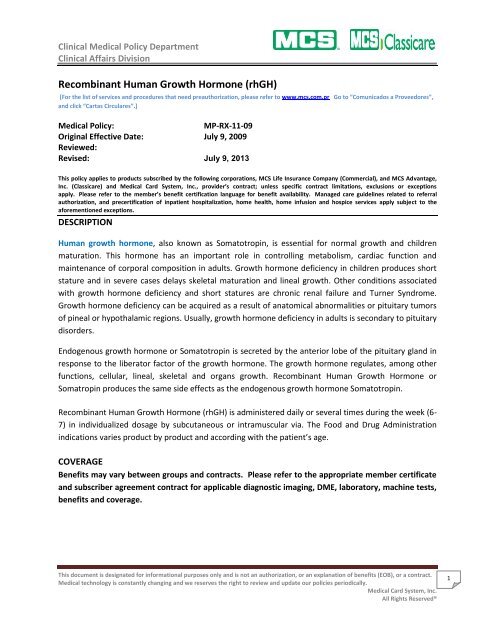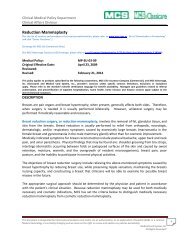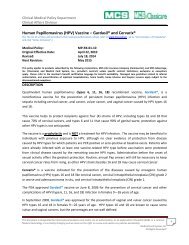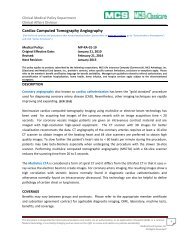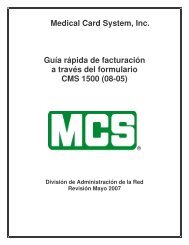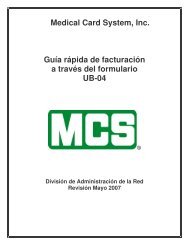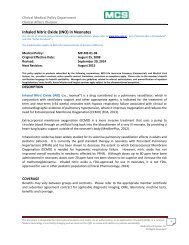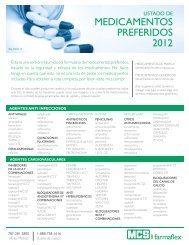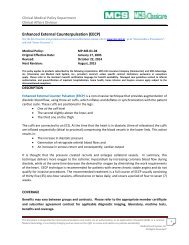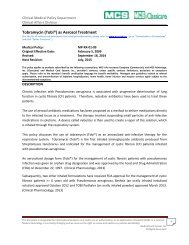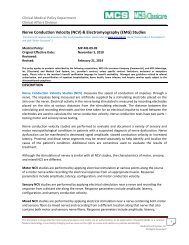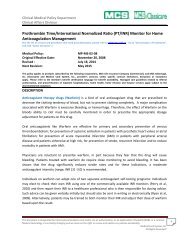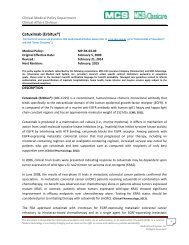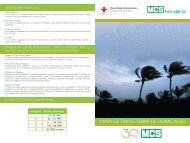Recombinant Human Growth Hormone (rhGH) - MCS a
Recombinant Human Growth Hormone (rhGH) - MCS a
Recombinant Human Growth Hormone (rhGH) - MCS a
You also want an ePaper? Increase the reach of your titles
YUMPU automatically turns print PDFs into web optimized ePapers that Google loves.
Clinical Medical Policy Department<br />
Clinical Affairs Division<br />
<strong>Recombinant</strong> <strong>Human</strong> <strong>Growth</strong> <strong>Hormone</strong> (<strong>rhGH</strong>)<br />
[For the list of services and procedures that need preauthorization, please refer to www.mcs.com.pr Go to “Comunicados a Proveedores”,<br />
and click “Cartas Circulares”.]<br />
Medical Policy:<br />
MP-RX-11-09<br />
Original Effective Date: July 9, 2009<br />
Reviewed:<br />
Revised: July 9, 2013<br />
This policy applies to products subscribed by the following corporations, <strong>MCS</strong> Life Insurance Company (Commercial), and <strong>MCS</strong> Advantage,<br />
Inc. (Classicare) and Medical Card System, Inc., provider’s contract; unless specific contract limitations, exclusions or exceptions<br />
apply. Please refer to the member’s benefit certification language for benefit availability. Managed care guidelines related to referral<br />
authorization, and precertification of inpatient hospitalization, home health, home infusion and hospice services apply subject to the<br />
aforementioned exceptions.<br />
DESCRIPTION<br />
<strong>Human</strong> growth hormone, also known as Somatotropin, is essential for normal growth and children<br />
maturation. This hormone has an important role in controlling metabolism, cardiac function and<br />
maintenance of corporal composition in adults. <strong>Growth</strong> hormone deficiency in children produces short<br />
stature and in severe cases delays skeletal maturation and lineal growth. Other conditions associated<br />
with growth hormone deficiency and short statures are chronic renal failure and Turner Syndrome.<br />
<strong>Growth</strong> hormone deficiency can be acquired as a result of anatomical abnormalities or pituitary tumors<br />
of pineal or hypothalamic regions. Usually, growth hormone deficiency in adults is secondary to pituitary<br />
disorders.<br />
Endogenous growth hormone or Somatotropin is secreted by the anterior lobe of the pituitary gland in<br />
response to the liberator factor of the growth hormone. The growth hormone regulates, among other<br />
functions, cellular, lineal, skeletal and organs growth. <strong>Recombinant</strong> <strong>Human</strong> <strong>Growth</strong> <strong>Hormone</strong> or<br />
Somatropin produces the same side effects as the endogenous growth hormone Somatotropin.<br />
<strong>Recombinant</strong> <strong>Human</strong> <strong>Growth</strong> <strong>Hormone</strong> (<strong>rhGH</strong>) is administered daily or several times during the week (6-<br />
7) in individualized dosage by subcutaneous or intramuscular via. The Food and Drug Administration<br />
indications varies product by product and according with the patient’s age.<br />
COVERAGE<br />
Benefits may vary between groups and contracts. Please refer to the appropriate member certificate<br />
and subscriber agreement contract for applicable diagnostic imaging, DME, laboratory, machine tests,<br />
benefits and coverage.<br />
This document is designated for informational purposes only and is not an authorization, or an explanation of benefits (EOB), or a contract.<br />
Medical technology is constantly changing and we reserves the right to review and update our policies periodically.<br />
Medical Card System, Inc.<br />
All Rights Reserved®<br />
1
Clinical Medical Policy Department<br />
Clinical Affairs Division<br />
INDICATIONS<br />
Medical Card System, Inc. (<strong>MCS</strong>) will consider recombinant growth hormone medically necessary for<br />
treatment of members in the following diagnostic categories who meet the criteria set forth below:<br />
A. Adults:<br />
1. Adult Members with hypothalamic - pituitary disease<br />
2. Pituitary tumor<br />
3. Damage secondary to pituitary surgery<br />
4. Hypothalamic disease<br />
5. Radiation<br />
6. Trauma (e.g. head trauma or central nervous system infection)<br />
7. Confirmed growth hormone deficiency for either childhood (secondary to congenital,<br />
genetic, acquired, or idiopathic causes) onset or adult onset (endogenous or associated with<br />
multiple hormone deficiencies, i.e., hypopituitarism, as a result of pituitary disease, surgery<br />
or radiation therapy)<br />
8. For the treatment of short bowel syndrome in patients receiving specialized nutrition<br />
support as directed by a health care professional.<br />
9. For the treatment of HIV-associated adipose redistribution syndrome (HARS) †.<br />
† = Off-label indication<br />
B. Children and Adolescents:<br />
1. Children with history of hypothalamic - pituitary disease<br />
2. Short stature associated with chronic renal insufficiency previous renal transplant<br />
3. Short stature in patients with Turner Syndrome (TS) i<br />
4. Short stature in patients with Prader Willis Syndrome (PWS) ii<br />
5. Short Stature in patients with Noonan’s Syndrome iii<br />
6. Infants born short for their gestational age (SGA) who have not reach their expected stature at<br />
two to four years of age or that presented the restriction diagnosis in the intrauterine growth<br />
(IUGR). GH or IGF-I levels are not needed for this diagnosis.<br />
7. Trauma (e.g. traumatic delivery in the neonate)<br />
8. For the long-term treatment of growth failure in children who have growth hormone deficiency<br />
due to inadequate growth hormone secretion.<br />
9. For short stature in children with SHOX (short stature homeobox-containing gene) deficiency.<br />
10. For idiopathic short stature.<br />
11. For the treatment of HIV-associated failure to thrive in children, AIDS-associated wasting<br />
syndrome, or cachexia.<br />
This document is designated for informational purposes only and is not an authorization, or an explanation of benefits (EOB), or a contract.<br />
Medical technology is constantly changing and we reserves the right to review and update our policies periodically.<br />
Medical Card System, Inc.<br />
All Rights Reserved®<br />
2
Clinical Medical Policy Department<br />
Clinical Affairs Division<br />
CONTRAINDICATIONS/LIMITATIONS<br />
Medical Card System, Inc. (<strong>MCS</strong>) DOES NOT cover Somatropin for the following indications because<br />
they are considered experimental, investigational or unproven (this list may not be all-inclusive):<br />
A. <strong>Growth</strong> <strong>Hormone</strong> Use in Adults:<br />
1. Continuation of growth hormone treatment from childhood use once epiphyses are closed<br />
(except as defined in adult growth hormone coverage conditions)<br />
2. Obesity<br />
3. Osteoporosis<br />
4. Muscular dystrophy<br />
5. Infertility<br />
6. Somatopause<br />
7. Repeat courses of therapy in Short Bowel Syndrome<br />
8. Crohn’s disease<br />
B. <strong>Growth</strong> <strong>Hormone</strong> Use in Children:<br />
1. Russell-Silver Syndrome<br />
2. Skeletal dysplasias, (i.e., acondroplastia)<br />
3. Osteogenesis imperfecta<br />
4. Down Syndrome and other syndromes associated with short stature and malignant diathesis<br />
5. Continuation of growth hormone treatment for growth promotion once epiphyses are closed<br />
6. Deletion of chromosome 18q<br />
7. Chromosomal anomalies unless otherwise specified as covered<br />
8. Precocious puberty<br />
9. Juvenile rheumatoid arthritis<br />
10. Crohn’s disease<br />
11. Repeat courses of therapy in Short Bowel Syndrome<br />
C. General Contraindications and Warnings:<br />
1. Somatropin products should not be used in any patient with a known hypersensitivity to<br />
Somatropin or any of the product excipients.<br />
2. Hypersensitivity to benzyl alcohol.<br />
3. Hypersensitivity to metacresol.<br />
4. Patients with Active Neoplastic Disease.<br />
This document is designated for informational purposes only and is not an authorization, or an explanation of benefits (EOB), or a contract.<br />
Medical technology is constantly changing and we reserves the right to review and update our policies periodically.<br />
Medical Card System, Inc.<br />
All Rights Reserved®<br />
3
Clinical Medical Policy Department<br />
Clinical Affairs Division<br />
5. Patients with acute critical illness due to complications following open heart or abdominal<br />
surgery, multiple accidental traumas or to patients having acute respiratory insufficiency.<br />
6. Somatropin should be used cautiously in patients with diabetes mellitus. Patients with diabetes<br />
or glucose intolerance and those patients with risk factors for diabetes or glucose intolerance<br />
should be monitored closely during treatment with Somatropin.<br />
7. Diabetic retinopathy, active proliferative or severe non-proliferative.<br />
8. Patients with a history of scoliosis should receive Somatropin with caution.<br />
9. Somatropin therapy has been reported to cause increased intracranial pressure with<br />
papilledema, visual changes, headache, and nausea and/or vomiting.<br />
10. Underlying intracranial tumor, evidence of progression or recurrence.<br />
11. Patients who develop persistent, severe abdominal pain during Somatropin treatment should be<br />
evaluated for pancreatitis, especially pediatric patients.<br />
12. Somatropin is contraindicated for growth promotion in pediatric patients with epiphyseal<br />
closure.<br />
13. Somatropin is contraindicated for use in pediatric patients with Prader-Willi syndrome and<br />
obesity as there have been reports of fatalities.<br />
14. <strong>Hormone</strong> replacement therapy should be monitored closely when somatropin therapy is<br />
administered to patients with hypopituitarism (multiple hormone deficiencies).<br />
15. Somatropin must be administered with caution during pregnancy and could affect the<br />
reproduction capacity.<br />
16. Somatropin must be administered cautiously in breast feeding mothers; it is excreted into<br />
human breast milk.<br />
17. During treatment with Somatropin, Turner’s syndrome patients should be evaluated carefully<br />
for Otitis and other ear disorders since these patients have an increased risk of ear or hearing<br />
disorders.<br />
18. Dose selection for an elderly patient should be cautions, usually starting at the low end of the<br />
dosing range, reflecting the greater frequency of decreased hepatic, renal, or cardiac function,<br />
and of concomitant disease or other drug therapy.<br />
CODING INFORMATION<br />
HCPCS CODES (List may not be all inclusive)<br />
HCPCS® CODES<br />
DESCRIPTION<br />
J2941<br />
Injection, Somatropin, 1mg<br />
2013 HCPCS LEVEL II Professional Edition® (American Medical Association).<br />
This document is designated for informational purposes only and is not an authorization, or an explanation of benefits (EOB), or a contract.<br />
Medical technology is constantly changing and we reserves the right to review and update our policies periodically.<br />
Medical Card System, Inc.<br />
All Rights Reserved®<br />
4
Clinical Medical Policy Department<br />
Clinical Affairs Division<br />
ICD-9 CM® Diagnosis Codes (List may not be all inclusive)<br />
ICD-9 CM® CODES<br />
DESCRIPTION<br />
042 <strong>Human</strong> immunodeficiency virus (HIV) disease<br />
194.3 Malignant neoplasm of other endocrine glands and related structures, pituitary<br />
gland and craniopharyngeal duct<br />
227.3 Benign neoplasm of other endocrine glands and related structures, pituitary<br />
gland and craniopharyngeal duct pouch<br />
253.2 Panhypopituitarism<br />
253.3 Disorders of the pituitary gland and its hypothalamic control, pituitary dwarfism<br />
253.7 Iatrogenic pituitary disorders<br />
259.4 Dwarfism, not elsewhere classified<br />
579.3 Other and Unspecified postsurgical non-absorption<br />
579.8 Other specified intestinal malabsorption<br />
585.1 Chronic Kidney disease, Stage I<br />
585.2 Chronic Kidney disease, Stage II (mild)<br />
585.3 Chronic Kidney disease, Stage III (moderate)<br />
585.4 Chronic Kidney disease, Stage IV (severe)<br />
585.5 Chronic Kidney disease, Stage V<br />
585.6 End stage renal disease<br />
585.9 Chronic kidney disease, unspecified<br />
588.0 Renal osteodystrophy<br />
758.6 Chromosomal anomalies, gonadal dysgenesis (Turner’s syndrome)<br />
759.81 Other specified anomalies, Prader-Willi syndrome<br />
This document is designated for informational purposes only and is not an authorization, or an explanation of benefits (EOB), or a contract.<br />
Medical technology is constantly changing and we reserves the right to review and update our policies periodically.<br />
Medical Card System, Inc.<br />
All Rights Reserved®<br />
5
Clinical Medical Policy Department<br />
Clinical Affairs Division<br />
759.89 Other specified anomalies, other (Noonan’s syndrome)<br />
764.90 Unspecified Fetal growth retardation, unspecified (weight)<br />
764.91 Unspecified Fetal growth retardation, less than 500 grams<br />
764.92 Unspecified Fetal growth retardation, 500 – 749 grams<br />
764.93 Unspecified Fetal growth retardation, 750 – 999 grams<br />
764.94 Unspecified Fetal growth retardation, 1000 –1249 grams<br />
764.95 Unspecified Fetal growth retardation, 1250 –1499 grams<br />
764.96 Unspecified Fetal growth retardation, 1500 –1749 grams<br />
764.97 Unspecified Fetal growth retardation, 1750 –1999 grams<br />
764.98 Unspecified Fetal growth retardation, 2000 –2499 grams<br />
764.99 Unspecified Fetal growth retardation, 2500 or and over<br />
799.4 Cachexia<br />
909.2 Late effect of radiation<br />
958.4 Certain early complications of trauma, traumatic shock<br />
958.8 Certain early complications of trauma, other<br />
990 Effects of radiation, unspecified<br />
998.89 Other specified complications of procedures, not elsewhere classified, other<br />
specified complications<br />
2013 ICD-9-CM®For Physicians, VOLUMES I & II, Professional Edition (American Medical Association)<br />
REFERENCES<br />
1. “Administración de seguros de salud de Puerto Rico. Solicitud de autorización para la hormona de<br />
crecimiento humana recombinante” (Pre-authorization Request for <strong>Recombinant</strong> <strong>Human</strong> <strong>Growth</strong><br />
<strong>Hormone</strong> [<strong>rhGH</strong>]). Approved Date: 12/19/2005. Revised Date: 8/28/2008. Document not available at<br />
Internet. Searched July 9, 2013.<br />
This document is designated for informational purposes only and is not an authorization, or an explanation of benefits (EOB), or a contract.<br />
Medical technology is constantly changing and we reserves the right to review and update our policies periodically.<br />
Medical Card System, Inc.<br />
All Rights Reserved®<br />
6
Clinical Medical Policy Department<br />
Clinical Affairs Division<br />
2. American academy of pediatrics. Considerations Related to the Use of <strong>Recombinant</strong> <strong>Human</strong> <strong>Growth</strong><br />
<strong>Hormone</strong> in Children. Pediatrics Vol. 99 No. 1 January 1, 1997. pp. 122 -129. Accessed July 09, 2013.<br />
Available at URL: http://pediatrics.aappublications.org/content/99/1/122.full.pdf+html<br />
3. American Association of Clinical Endocrinologists. AACE Medical Guidelines for Clinical Practice for<br />
<strong>Growth</strong> <strong>Hormone</strong> – New 2009 Update. Endocrine Practice Vol. 15 (Suppl 2) September/October 2009 or<br />
Guidelines for Use of <strong>Growth</strong> <strong>Hormone</strong> in Clinical Practice, Endocr Pract. 2009; 15(Suppl 2). Accessed<br />
July 05, 2013. Available at URL address: https://www.aace.com/files/growth-hormone-guidelines.pdf<br />
4. ECRI Institute. <strong>Recombinant</strong> <strong>Human</strong> <strong>Growth</strong> <strong>Hormone</strong> (<strong>rhGH</strong>) in Managing Turner’s syndrome.<br />
Publication Date: 11/09/2004. Searched on July 09, 2013. Document not available at URL address:<br />
https://members2.ecri.org/Components/Hotline/Pages/8397.aspx.<br />
5. Gold Standard / Elsevier. Clinical Pharmacology. www.clinicalpharmacology.com. Somatropin. Last<br />
Revision Date: 4/19/2012. Revision Date: 7/26/2011 Accessed July 02, 2013. Document available at URL<br />
address:<br />
https://www.clinicalpharmacology.com/Forms/Monograph/monograph.aspxcpnum=1564&sec=monin<br />
di&t=0<br />
6. National Guideline Clearinghouse. Title: Evaluation and treatment of adult growth hormone<br />
deficiency: an Endocrine Society clinical practice guideline. Released Date: 2006. Document Available at<br />
URL address http://www.guideline.gov/content.aspxid=9311. This guideline has been replaced by an<br />
updated version completed June 2011. Accessed July 05, 2013. Document available at URL address:<br />
http://www.guideline.gov/content.aspxid=34450<br />
7. Thomson Micromedex® DrugDex. Somatropin - Indications & Contraindications. Retrieved July 02,<br />
2013. from https://www.thomsonhc.com/micromedex2<br />
8. www.chromsome18.org. The Chromosome 18 Registry & Research Society. Distal 18q. 2009.<br />
Accessed July 08, 2013. Available at URL:<br />
http://www.chromosome18.org/LinkClick.aspxfileticket=hfLGlJST6mk%3d&tabid=127<br />
POLICY HISTORY<br />
DATE ACTION COMMENT<br />
July 9, 2009<br />
Origination of Policy<br />
July 9, 2010 Revised I. Under Indications: indication for children added “Short Stature patients<br />
with Noonan’s Syndrome”.<br />
II. New investigational/experimental section added to policy as stated<br />
This document is designated for informational purposes only and is not an authorization, or an explanation of benefits (EOB), or a contract.<br />
Medical technology is constantly changing and we reserves the right to review and update our policies periodically.<br />
Medical Card System, Inc.<br />
All Rights Reserved®<br />
7
Clinical Medical Policy Department<br />
Clinical Affairs Division<br />
below: <strong>MCS</strong> does not cover Somatropin for the following indications<br />
because they are considered experimental, investigational or unproven<br />
(this list may not be all-inclusive):<br />
A. <strong>Growth</strong> <strong>Hormone</strong> Use in Children:<br />
• Russell-Silver Syndrome<br />
• Skeletal dysplasias, (i.e., acondroplastia)<br />
• Osteogenesis imperfecta<br />
• Down Syndrome and other syndromes associated with short stature and<br />
malignant diathesis<br />
• Continuation of growth hormone treatment for growth promotion once<br />
epiphyses are closed<br />
• Deletion of chromosome 18q<br />
• Chromosomal anomalies unless otherwise specified as covered<br />
• Precocious puberty<br />
• Juvenile rheumatoid arthritis<br />
• Crohn’s disease<br />
• Repeat courses of therapy in Short Bowel Syndrome<br />
B.<strong>Growth</strong> <strong>Hormone</strong> Use in Adults:<br />
• Continuation of growth hormone treatment from childhood use once<br />
epiphyses are closed (except as defined in adult growth hormone<br />
coverage conditions)<br />
• Obesity<br />
• Osteoporosis<br />
• Muscular dystrophy<br />
• Infertility<br />
• Somatopause<br />
• Repeat courses of therapy in Short Bowel Syndrome<br />
• Crohn’s disease<br />
III.Endnote added with definitions on Turner’s syndrome, Prader-Willie<br />
and Noonan’s Syndrome.<br />
This document is designated for informational purposes only and is not an authorization, or an explanation of benefits (EOB), or a contract.<br />
Medical technology is constantly changing and we reserves the right to review and update our policies periodically.<br />
Medical Card System, Inc.<br />
All Rights Reserved®<br />
8
Clinical Medical Policy Department<br />
Clinical Affairs Division<br />
July 6, 2011<br />
Yearly Review<br />
August 7, 2012 Revised References updated.<br />
To the Adults’ Indications Section - modified Indication # 7: for either<br />
childhood (secondary to congenital, genetic, acquired, or idiopathic<br />
causes) onset or adult onset (endogenous or associated with multiple<br />
hormone deficiencies, i.e., hypopituitarism, as a result of pituitary<br />
disease, surgery or radiation therapy). Also, Added New Indications 8-10.<br />
To the Children and Adolescents’ Indications Section – Added to<br />
Indication #6: two to four years as a valid age to evaluate gestational age<br />
in relation to size.<br />
New Indications 8-11 were added.<br />
New General Contraindications Section, # 1-11, was added.<br />
July 9, 2013 Yearly Review 1. References updated.<br />
2. General Contraindications and Warnings # 12-18 were added<br />
to the policy.<br />
3. The ICD#9 section was reviewed.<br />
i<br />
Turner’s syndrome is a chromosomal disorder occurring exclusively in girls with an absence or a defect in chromosome 45X. The disorder<br />
results in lack of sexual development at puberty, short stature, webbed neck and a variety of heart defects. Turner’s syndrome is diagnosed in<br />
approximately one in 2000 to 3000 live female births. The reason for short stature in nearly all girls with Turner’s syndrome is probably from an<br />
impaired response to GH rather than a deficiency of the hormone. Treatment with growth hormone, anabolic steroids and estrogen are<br />
required to improve physical and sexual development.<br />
ii Prader-Willi syndrome affects multiple systems resulting in infantile hypotonia and failure to thrive,<br />
Hypogonadism, short stature, learning disabilities and hyperphagia beginning at one to three years of age that leads to obesity. Prader-Willi<br />
syndrome is rare, occurring in approximately one in 10,000 to 25,000 live births; approximately 17,000 to 22,000 children in the U.S. have<br />
Prader-Willi syndrome. Sixty percent of children (primarily boys) diagnosed with Prader-Willi syndrome have abnormal chromosomes; either a<br />
three to four million base-pair deletion of the paternal chromosome 15q11q13, or both fifteenth chromosomes are inherited from the mother.<br />
iii<br />
Noonan syndrome is a genetic disorder that causes abnormal development of multiple parts of the body. It used to be called Turner-like<br />
syndrome because certain signs (webbing of neck and abnormally shaped chest) resembled those seen in Turner syndrome. Management<br />
focuses on controlling the disease's symptoms and complications. <strong>Growth</strong> hormone may be used to treat short stature in some people who<br />
have Noonan syndrome.<br />
This document is for informational purposes only. It is not an authorization, certification, explanation of benefits, or contract. Receipt of<br />
benefits is subject to satisfaction of all terms and conditions of coverage. Eligibility and benefit coverage are determined in accordance with<br />
the terms of the member’s plan in effect as of the date services are rendered. Medical Card System, Inc., (<strong>MCS</strong>) medical policies are<br />
developed with the assistance of medical professionals and are based upon a review of published and unpublished information including, but<br />
not limited to, current medical literature, guidelines published by public health and health research agencies, and community medical<br />
practices in the treatment and diagnosis of disease. Because medical practice, information, and technology are constantly changing, Medical<br />
Card System, Inc., (<strong>MCS</strong>) reserves the right to review and update its medical policies at its discretion. Medical Card System, Inc.; (<strong>MCS</strong>)<br />
medical policies are intended to serve as a resource to the plan. They are not intended to limit the plan’s ability to interpret plan language as<br />
deemed appropriate. Physicians and other providers are solely responsible for all aspects of medical care and treatment, including the type,<br />
quality, and levels of care and treatment they choose to provide.<br />
This document is designated for informational purposes only and is not an authorization, or an explanation of benefits (EOB), or a contract.<br />
Medical technology is constantly changing and we reserves the right to review and update our policies periodically.<br />
Medical Card System, Inc.<br />
All Rights Reserved®<br />
9


